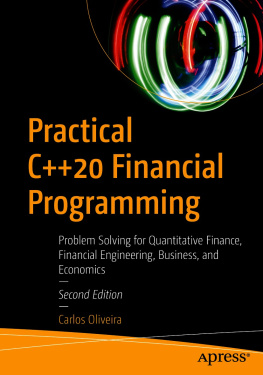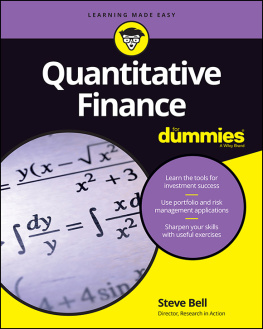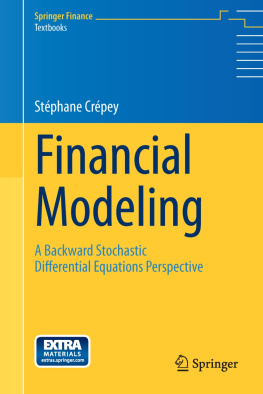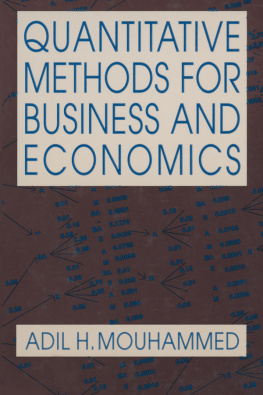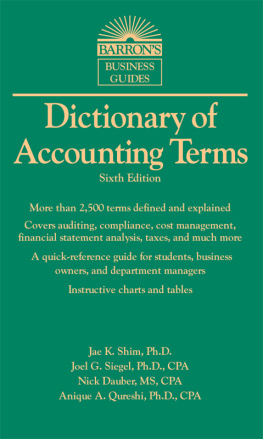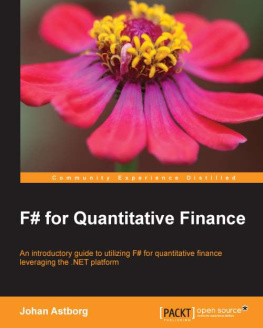Carlos Oliveira - Problem Solving for Quantitative Finance, Financial Engineering, Business, and Economics
Here you can read online Carlos Oliveira - Problem Solving for Quantitative Finance, Financial Engineering, Business, and Economics full text of the book (entire story) in english for free. Download pdf and epub, get meaning, cover and reviews about this ebook. publisher: Apress, genre: Computer. Description of the work, (preface) as well as reviews are available. Best literature library LitArk.com created for fans of good reading and offers a wide selection of genres:
Romance novel
Science fiction
Adventure
Detective
Science
History
Home and family
Prose
Art
Politics
Computer
Non-fiction
Religion
Business
Children
Humor
Choose a favorite category and find really read worthwhile books. Enjoy immersion in the world of imagination, feel the emotions of the characters or learn something new for yourself, make an fascinating discovery.
- Book:Problem Solving for Quantitative Finance, Financial Engineering, Business, and Economics
- Author:
- Publisher:Apress
- Genre:
- Rating:5 / 5
- Favourites:Add to favourites
- Your mark:
- 100
- 1
- 2
- 3
- 4
- 5
Problem Solving for Quantitative Finance, Financial Engineering, Business, and Economics: summary, description and annotation
We offer to read an annotation, description, summary or preface (depends on what the author of the book "Problem Solving for Quantitative Finance, Financial Engineering, Business, and Economics" wrote himself). If you haven't found the necessary information about the book — write in the comments, we will try to find it.
Carlos Oliveira: author's other books
Who wrote Problem Solving for Quantitative Finance, Financial Engineering, Business, and Economics? Find out the surname, the name of the author of the book and a list of all author's works by series.
Problem Solving for Quantitative Finance, Financial Engineering, Business, and Economics — read online for free the complete book (whole text) full work
Below is the text of the book, divided by pages. System saving the place of the last page read, allows you to conveniently read the book "Problem Solving for Quantitative Finance, Financial Engineering, Business, and Economics" online for free, without having to search again every time where you left off. Put a bookmark, and you can go to the page where you finished reading at any time.
Font size:
Interval:
Bookmark:
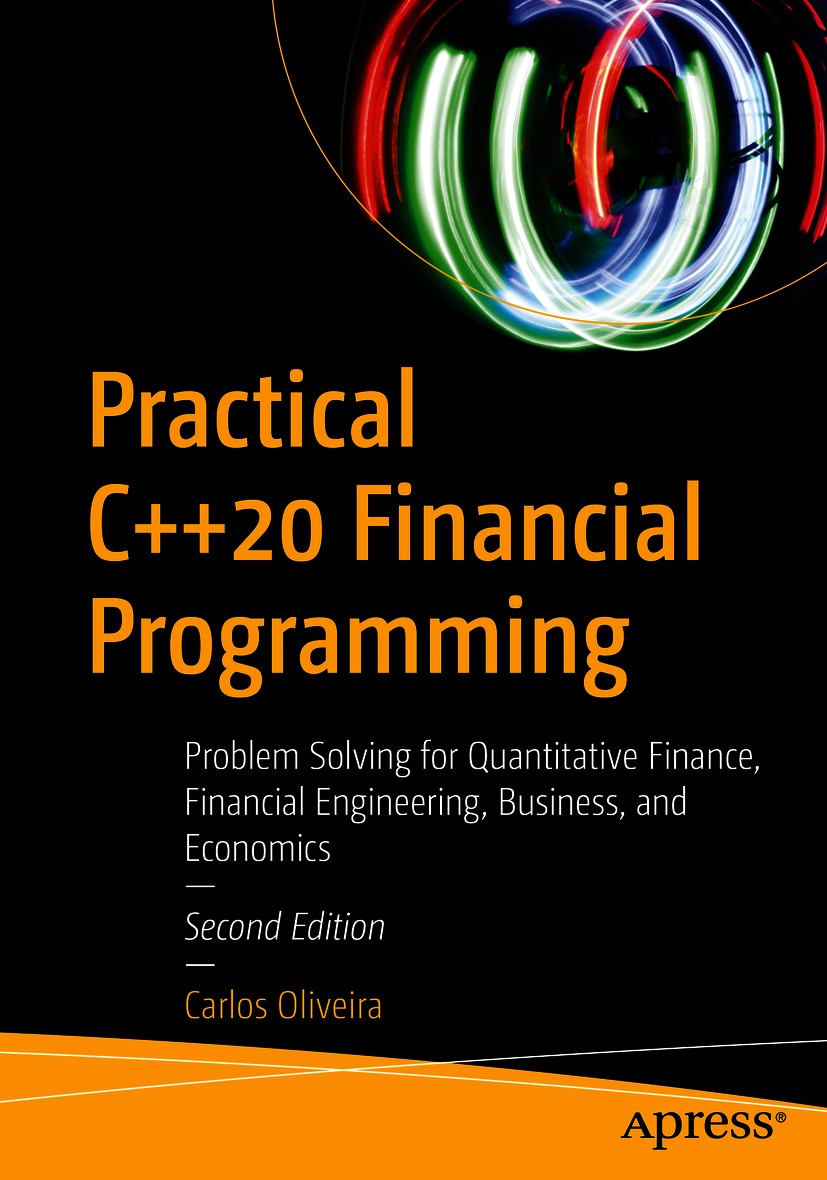

Any source code or other supplementary material referenced by the author in this book is available to readers on GitHub via the books product page, located at www.apress.com/9781484268339 and on coliveira.net/. For more detailed information, please visit http://www.apress.com/source-code .
To my family, my real source of inspiration.
This is a hands-on book for programmers who want to learn about how C++20 is used in the financial industry. The book concentrates on the parts of the language that are more frequently used to write financial software, including the STL (standard template library), templates, and support for numerical libraries. I also describe many of the important problems in financial engineering that are part of the day-to-day work of financial programmers and quantitative analysts in investment banks and hedge funds.
The book provides how-to examples that cover all the major tools and concepts used to build working solutions for financial applications. Each chapter teaches readers how to use advanced C++ concepts as well as the basic building libraries used by modern C++ developers, such as the STL and Boost. I discuss how to create correct and efficient applications, leveraging knowledge of object-oriented and template-based programming. I assume only a basic knowledge of C and C++ and build on these concepts to explain techniques already mastered by developers who are familiar with modern C++.
In the process of writing this book, I was concerned with providing a great value for readers who are trying to use their programming knowledge to become proficient in the style of programming used in financial institutions such as banks, hedge funds, and other companies in the financial industry. However, I have introduced the topics covered in the book in a logical and structured way, so that even novice programmers will be able to absorb the most important topics and competencies necessary to develop financial applications in C++.
An important feature of the book is its focus on specific themes and practical solutions for financial problems. While the emphasis is not on the theoretical aspects of finance, I do discuss topics such as numerical algorithms, integration techniques, and differential equations for derivative valuation. Moreover, the reader will gain a good understanding of how to model such problems using modern C++ concepts.
The financial literature for programmers typically has a large number of books written from an academic standpoint, with most of the time spent on the discussion of mathematics concepts behind algorithms, rather than the software engineering challenges that developers need to overcome. Therefore, in this book, I decided to focus on working solutions for common programming problems, in the form of code examples, offering readers much more value for their reading efforts.
This book is intended for readers who already have a working knowledge of programming in C, C++, or another mainstream language. These are usually professionals or advanced students in computer science, engineering, physics, and mathematics, who have an interest in learning C++20 financial programming either for personal improvement or for professional reasons. The book is also directed at practitioners of C++ programming in financial institutions, who would use the book as a ready-to-use reference for common development problems.
By reading this book, you will learn how to use modern C++20 techniques to implement practical applications. Being a multi-paradigm language, C++ is used slightly differently in each application area. Therefore, skills that are valuable for developing desktop applications are not necessarily the same as those used to write high-performance software. A large part of major high-performance financial applications are written in C++, which means that programmers who want to enter this lucrative market need to acquire a working knowledge of a few specific and relevant parts of the language. This book therefore would be an excellent choice for developers who want to advance their knowledge effectively while learning one of the most sought-after and marketable skill sets for modern applications and high-performance software development.
Here is a brief overview of the contents of each chapter.
ChapterThe Fixed Income Market: The fixed income market is a large part of the financial engineering industry, and it presents unique computational challenges for its practitioners. C++ programming is widely used in this area, offering the ability to compute rates and cash flow variations with incredible speed, as readers will learn in this chapter. I present C++ coding examples that can be used in the solution of some of the most common problems occurring in fixed income markets. I include C++ algorithms for topics such as (1) interest rate calculation, (2) present value computation, (3) cash flows, and (4) valuation of bonds.
ChapterThe Equities Market: Equity markets are multifaceted and offer a great variety of investment vehicles. As a result, the number and complexity of computational techniques used for financial analysis of equity markets continue to grow. In this chapter, I present C++ examples for a few selected problems occurring in the equities markets and their derivatives. I cover programming topics such as the following: (1) moving average computation, (2) calculating volatility, (3) computing instrument correlation, and (3) calculating fundamental indicators.
Font size:
Interval:
Bookmark:
Similar books «Problem Solving for Quantitative Finance, Financial Engineering, Business, and Economics»
Look at similar books to Problem Solving for Quantitative Finance, Financial Engineering, Business, and Economics. We have selected literature similar in name and meaning in the hope of providing readers with more options to find new, interesting, not yet read works.
Discussion, reviews of the book Problem Solving for Quantitative Finance, Financial Engineering, Business, and Economics and just readers' own opinions. Leave your comments, write what you think about the work, its meaning or the main characters. Specify what exactly you liked and what you didn't like, and why you think so.

